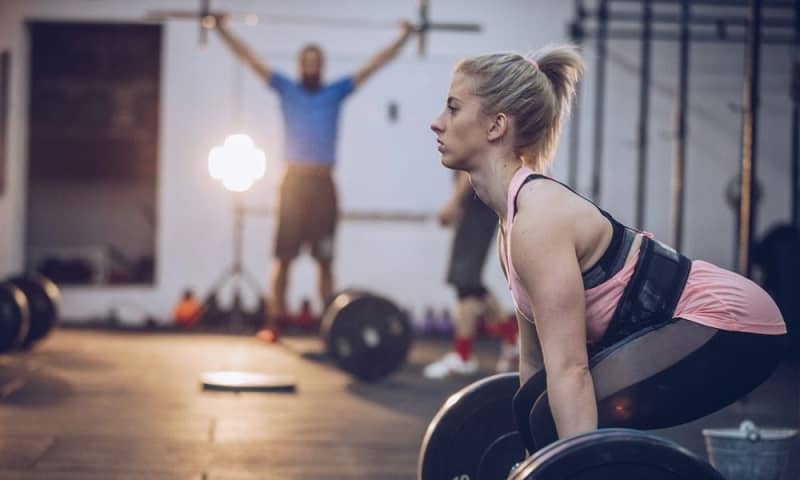
26 Jul Do Men or Women Build Muscle Mass Faster | Male vs Female Gains
What comes to your mind when you hear the word bodybuilding? Probably, big and bulkier men in fitting gym wear lifting heavy weights.
Well, you’re not alone. Most people still don’t envision women lifting heavier weights and bulking up.
With the visible difference in muscle gains between males and females, it’s obvious to question do men build muscle faster than women.
So, is it harder for women to gain muscle, or is it just another bodybuilding myth?
Undoubtedly, men and women are different from each other in terms of body composition and anatomy. However, if you think women can’t build muscles as much as men, that’s not exactly true.
Here’s the blog to bust all your myths regarding male vs female muscle gain. This blog explains the reasons behind the visible muscle gain difference between men and women with evidence and studies.
Do Men Build Muscle Faster Than Women?
The fitness sphere is often bombarded with myths and misconceptions.
While the stereotypes continue to exist, there’s no denying the fact that more women of all ages are seeking weight lifting and strength training to stay healthy and buffed.
However, when it comes to building muscles, people often think men do build muscle mass faster than women. Nonetheless, that’s not true at all.
As published in the journal of Medicine & Science in Sports & Exercise, regardless of the racial differences and sex, strength training does not alter subcutaneous or intramuscular fat.
Further, a study analyzed the skeletal muscle adaptations during the early phase of resistance training in men and women. For this, a lower extremity progressive resistance training program was performed for 8 weeks (twice every week).
After analyzing the muscle dynamic strength and muscle biopsies, the data suggests skeletal muscle adaptations contributing to strength gains of the lower extremity are similar for women and men during resistance training.
So, can men build muscle faster than women?
Well, it doesn’t seem so. It’s a myth that women have a hard time developing muscles than men. Both men and women develop muscle gains equally. The only thing is that men have more muscle mass when they get started.
The following segment explains this in more detail.
Why Do Men Appear More Muscular Than Women?
The first thing—people unnecessarily drag gender into the discussion when it comes to lifting weights and gaining muscles.
However, the truth is far from what it seems. You may or may not gain muscles at a certain speed, and the reason could be anything but your sex.
You may wonder at this time “so, why do men appear bulkier than women?”
Well, males and females are quite different in some areas, which gives men advantages when it comes to “appearing muscular.”
#1. Men Have More Muscle Mass Than Females
Yes, you read that right!
As compared to females, males have more muscle mass (both in absolute and relative terms).
You may come across men and women of the same age and height. However, men will have more muscles as compared to women. The difference between the muscle mass ratio in women and men is proven.
A study analyzed 20 volunteers (Japanese college students) to determine the sex differences in regional and total skeletal muscle distribution.
Men had larger and more total regional muscle mass as compared to women.
Furthermore, both men and women can gain muscle mass through long-term strength training.
#2. Male vs Female Hormones
Hormones have a huge role to play in maximizing your muscle mass. It can also be held accountable for why people often think women can’t build muscles as men.
The human body consists of both estrogen (female hormones) and testosterone (male sex hormone).
Notably, testosterone is majorly responsible for growing muscles and increasing strength. Testosterone accelerates protein breakdown and synthesis.
Additionally, women have only 10% of the testosterone as compared to men's testosterone levels.
As a result, naturally, men have bigger-looking muscles as compared to women. And, in certain cases, men with high testosterone, good genetics, and proper training also build more muscle.
PEOPLE ALSO READ: Full-Body Workouts to Increase Testosterone
#3. The Age Factor
Growing older comes with a lot of adverse changes and one of them is losing muscle mass.
While both men and women lose muscle as they age, a gender disparity exists here as well. Even though there’s no change in male and female muscle growth progression, age is an influencing factor in muscle sarcopenia.
As per a study in Anthropologischer Anzeiger, Journal of Biological and Clinical Anthropology, the prevalence of Sarcopenia, the age-related decline in muscle mass, has dramatic results.
This study analyzed the gender differences in the prevalence of sarcopenia among 139 elderly people. It concluded that the prevalence of sarcopenia differs between the two genders.
That is to say, in the youngest group (< 70 yrs.), the prevalence of sarcopenia was more among women. Whereas, in the oldest group (> 80 years), the results were the opposite.
Therefore, even though basal protein synthesis is higher in women as compared to men, they still lose more mass than men in the process of aging. As a result, men look more muscular for longer.
#4. The Difference in Body Fat and Mass
Gender-based differences in gaining muscle mass also exist in body-fat percentages.
It is known that women generally have more fat compared to men. For the same Body Mass Index, women have ~10% more body fat than men.
Not only this, as per research, women have more fat in the gluteal-femoral region. On the other hand, men tend to have more fat in their pelvic area.
Additionally, men have larger muscle fibers in their upper body. Thus, translating to higher metabolism. Whereas, women have a greater proportion of muscles in their lower body.
As a result, the muscle formulation appears to be more in men.
#5. Women Don’t Really Prefer Weightlifting
Let’s face it, women usually do not lift heavy weights. Many do not even like to do it as well. Women often believe that doing strength training will make them bulkier and give them a manly look.
However, this is more of a misconception. While there are women with stronger and bulkier bodies, it takes years to develop muscles like men.
Also, it’s a fact that women want to look more toned and lean rather than bulky.
Therefore, considering these reasons, men develop more mass compared to women and often appear bulkier.
Should This Mean Women Do the Same Training As Men to Build Muscle?

As for muscle growth and strength build-up, men and women don’t really show any significant difference.
So, you might wonder if men and women should do the same strength training.
Well, not necessarily!
It is because, despite the results, there do exist some differences between men and women. Hence, keeping that in mind, both sexes should train accordingly.
Account for the following factors before you decide your training routine:
#1. Women Have Better Endurance As Compared to Men
Women have more endurance compared to men. To elaborate, in women, strength training either converts the type I muscle fiber or doesn’t convert it at all. Whereas, in men, it converts to type IIa fibers.
Also, women have more resistance to fatigue. As a result, they are able to do more reps in a set. Therefore, considering this, women while training should utilize this benefit and do more reps.
#2. Women can Train with Heavier Loads
If you think women can’t lift heavier weights, you are absolutely wrong. More type I fibers allow women to better handle weights.
Sadly, women step back from lifting more weight. When trying to build muscles, women must realize that little neon weights aren’t going to be of much help.
#3. Response Vary According to Menstrual Cycle Phase
During the whole menstrual cycle, there is a dramatic shift in hormonal levels.
As per a paper published in the Journal of Strength and Conditioning Research, a woman’s body reacts differently to strength training during their menstrual cycle.
To elaborate, as analyzed in the study, women take longer to recover from training in the last half of the menstrual cycle. Additionally, there is an increase in strength and gains in the follicular phase, i.e., the first phase of the cycle.
#4. Women Have Better Muscle Recovery As Compared to Men
Faster muscle recovery is a blessing when you’re heavily into training. And certainly, women are blessed when it comes to faster muscle recovery.
A study determines the effect of training sessions on muscle recovery patterns.
As a result, the study concludes, that for a bench press exercise, a muscle recovery time of 48h for men and 4 h for women optimizes strength development.
#5. Male vs Female Upper Body Strength
It’s easy to think men have more strength as compared to women. However, this differs on the basis of the upper and lower body part.
To elaborate, men have better upper body strength, and women have higher lower body strength.
Accordingly, in males, the upper body has more significance to anabolic receptors as compared to the lower body. As a result, it is fairly easier for men to develop muscles in the upper body as compared to women.
However, that’s not always the case.
The best example for this is a study where 44 young men and 47 young women performed leg presses, chest presses, leg curls, and lat pulldowns. They performed it twice a week for 10 weeks.
The man vs woman strength test didn’t show any difference. While men improved by 11.61%, women improved by 11.76%.
So, the bottom line is, that while men have the advantage of high testosterone, that simply doesn’t mean women can’t build muscles.
Final Words
Muscle building has almost nothing to do with sex or gender.
If you’ve been wondering why do men build muscles faster than women, know that it’s more of a myth. Some researchers support the same statement.
While your gender might have some contribution to a muscly appearance, this isn’t an influencing factor for the actual speed of muscle gains.
Even women can build muscles at the same pace if they do proper strength training and weight lifting.
In fact, anyone can be benefited from strength training, and weight lifts, and get healthier irrespective of their sex.
Hopefully, now we’ve put an end to the battle of sexes. What do you think—is there more to muscle gains and gender? Do share your thoughts in the comments box.



No Comments